Dec 12, 2025
Dec 12, 2025
by Rachna
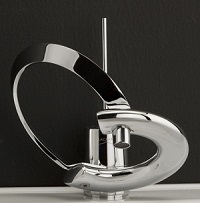 Having a look at this state of the art piece of sculpture one cannot think of it as a part of toilets the shauchalaya but this piece de resistance has to be part of a designer room taking us into the world of luxurious relaxation; an experience par excellence. In today’s scenario where we don’t have the bathrooms anymore but we deal more with the term of Glamour rooms let us have a look at how these actually evolved.
Having a look at this state of the art piece of sculpture one cannot think of it as a part of toilets the shauchalaya but this piece de resistance has to be part of a designer room taking us into the world of luxurious relaxation; an experience par excellence. In today’s scenario where we don’t have the bathrooms anymore but we deal more with the term of Glamour rooms let us have a look at how these actually evolved.
In the most literal sense, the word bathroom means “a room with a bath”. Because the traditional bathtubs have partly made way for modern showers, including steam showers, the more general definition is “a room where one bathes”. There can be just a shower, just a bathtub or both; and often both plumbing fixtures are combined in the bathtub. The room may also contain a sink, often called a “wash basin” or “hand basin” and often a “lavatory”.
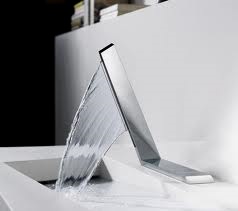 A bathroom is a room that may have different functions depending on the cultural context.
A bathroom is a room that may have different functions depending on the cultural context.
The “bathroom” (the more formal term being “restroom”) commonly means “a room containing a lavatory”. But in some countries this is usually called the “toilet” or alternatively a “water closet” (WC), lavatory or “loo”.
The bathrooms are generally categorized as a “full bathroom” (or “full bath”), containing four plumbing fixtures: bathtub, shower, toilet, and sink; “half (1/2) bath” (or “powder room”) containing just a toilet and sink; and “3/4 bath” containing toilet, sink, and shower, although the terms vary from market to market. In some markets, a toilet, sink, and shower are considered a “full bath”.
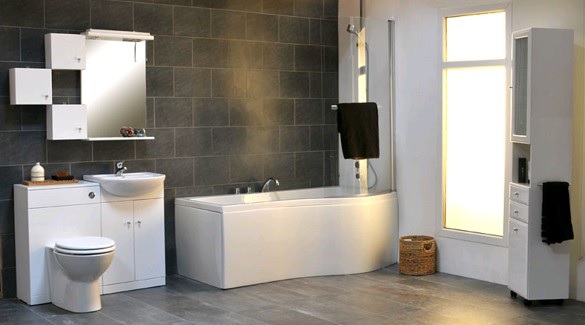
This lack of a single, universal definition commonly results in discrepancies between advertised and actual number of baths in real estate listings. An additional complication is that there are currently two ways of notating the number of bathrooms in a dwelling. One method is to count a half bathroom as “.5” and then add this to the number of full bathrooms (e.g., “2.5” baths would mean 2 full baths and 1 half bath). The other, newer method is to put the number of full bathrooms to the left side of the decimal point and to put the number of half bathrooms to the right of the decimal point (e.g., “2.1” would mean 2 full baths and 1 half bath; “3.2” would mean 3 full baths and 2 half baths).
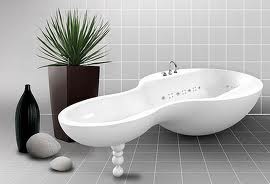 Nowadays these bathrooms are embellished with not just the designer tiles but the emphasis is on the themes each (bath) room portrays. The excellence in technology can be seen and experienced in the minutest of details beginning from the tiles, the sanitary wares to the faucets, the shelves, plants and accessories.
Nowadays these bathrooms are embellished with not just the designer tiles but the emphasis is on the themes each (bath) room portrays. The excellence in technology can be seen and experienced in the minutest of details beginning from the tiles, the sanitary wares to the faucets, the shelves, plants and accessories.
Despite the amount of time per day spent in this room the investments are high. These rest rooms are at par with the rest of the rooms if not ahead of them. The cost of constructing these embellished rooms has exceeded the total cost of a house.
History of bathrooms
Although it was not with hygiene in mind, the first records for the use of baths date back as far as 3000 B.C. At this time water had a strong religious value, being seen as a purifying element for both body and soul, and so it was not uncommon for people to be required to cleanse themselves before entering a sacred area. Baths are recorded as part of a village or town life throughout this period, with a split between steam baths in Europe and America and cold baths in Asia. Communal baths were erected in a distinctly separate area to the living quarters of the village, with a view to preventing evil spirits from entering the domestic quarters of a commune.
 In India the Kunds were constructed for communal baths. These were just outside the temple where the devotees cleansed themselves before entering the holy shrine(s). The other religious aspect being that after the daily bathing ritual water is offered to Aditya the sun god.
In India the Kunds were constructed for communal baths. These were just outside the temple where the devotees cleansed themselves before entering the holy shrine(s). The other religious aspect being that after the daily bathing ritual water is offered to Aditya the sun god.
Not all ancient baths were in the style of the large pools that often come to mind when one imagines the Roman baths; the earliest surviving bathtub dates back to 1700 B.C, and hails from the Palace of Knossos in Crete.
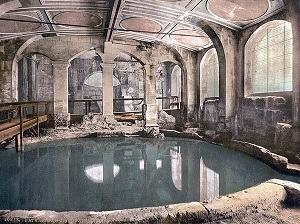 What is remarkable about this tub is not only the similarity with the baths of today, but also the way in which the plumbing works surrounding it differ so little from modern models. A more advanced prehistoric (15th century BC and before) system of baths and plumbing is to be found in the excavated town of Akrotiri, on the Aegean island of Thera. There, alabaster tubs and other bath fittings were found, along with a sophisticated twin plumbing system to transport hot and cold water separately. This was probably because of easy access to geothermic hot springs on this volcanic island. Both the Greeks and the Romans recognized the value of bathing as an important part of their lifestyles. Palaces have been uncovered throughout Greece with areas that are dedicated to bathing, spaces with ceramic bathtubs, as well as sophisticated drainage systems.
What is remarkable about this tub is not only the similarity with the baths of today, but also the way in which the plumbing works surrounding it differ so little from modern models. A more advanced prehistoric (15th century BC and before) system of baths and plumbing is to be found in the excavated town of Akrotiri, on the Aegean island of Thera. There, alabaster tubs and other bath fittings were found, along with a sophisticated twin plumbing system to transport hot and cold water separately. This was probably because of easy access to geothermic hot springs on this volcanic island. Both the Greeks and the Romans recognized the value of bathing as an important part of their lifestyles. Palaces have been uncovered throughout Greece with areas that are dedicated to bathing, spaces with ceramic bathtubs, as well as sophisticated drainage systems.
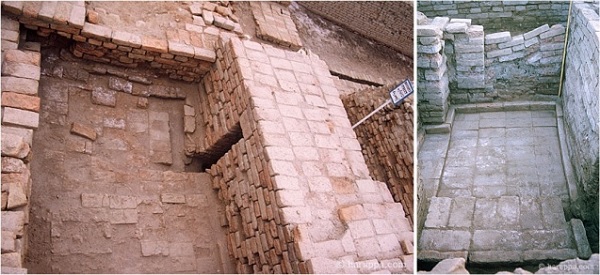
Even during Indus Valley Civilization archeologists have excavated one of the best drainage systems. In the Harappa and Mohenjo-Daro times, a bathing platform with a doorway leading into the room, with the brick floor made with carefully fitted flat paved bricks and a smaller catchment drain along the side of the platform has been uncovered. A small step was placed at one side of the platform, and a ledge of finely fitted bricks protected the base of the wall. Many a bathing platforms were made with watertight floors constructed with bricks laid on their edge.
The Roman attitudes towards bathing are well documented; they built large purpose-built thermal baths, marking not only an important social development, but also providing a public source of relaxation and rejuvenation. This was a place where people could meet to discuss the matters of the day and enjoy entertainment. During this period there was a distinction between private and public baths, with many wealthy families having their own thermal baths in their houses. Despite this they still made use of the public baths, showing the value that they had as a public institution. The strength of the Roman Empire was telling in this respect; imports from throughout the world allowed the Roman citizens to enjoy ointments, incense, combs, and mirrors.
Although some sources suggest that bathing declined following the collapse of the Roman Empire, this is not completely accurate. It was actually the Middle Ages that saw the beginning of soap production, proof that bathing was definitely not uncommon. It was only after the Renaissance that bathing declined; water was feared as a carrier of disease, and thus sweat baths and heavy perfumes were preferred.
In fact throughout the 16th, 17th, and 18th centuries, the use of public baths declined gradually in the west, and private spaces were favored, thus laying the foundations for the bathroom, as it was to become, in the 20th century. However, in Japan shared bathing in sento and onsen (spas) still exists; the latter being very popular.
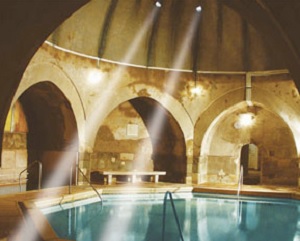 The Hamam (from Turkish: hamam) is the Turkish variant of a steam bath, which can be categorized as a wet relative of the sauna. In Western Europe, the Turkish bath as a method of cleansing the body and relaxation was particularly popular during the Victorian era.
The Hamam (from Turkish: hamam) is the Turkish variant of a steam bath, which can be categorized as a wet relative of the sauna. In Western Europe, the Turkish bath as a method of cleansing the body and relaxation was particularly popular during the Victorian era.
The process involved in taking a Turkish bath is similar to that of a sauna, but is more closely related to ancient Greek and ancient Roman bathing practices. A typical hamam consists of three interconnected basic rooms similar to its Roman ancestors: the sicaklik (or hararet -caldarium) which is the hot room, the warm room (tepidarium) which is the intermediate room and the sogukluk which is the cool room.
The sicaklik usually has a large dome decorated with small glass windows that create a half-light; it also contains a large marble stone called gobek tasi (tummy stone) at the center that the customers lie on, and niches with fountains in the corners. This room is for soaking up steam and getting scrub massages. The warm room is used for washing up with soap and water and the sogukluk is to relax, dress up, have a refreshing drink, sometimes tea, and where available, nap in private cubicles after the massage.
The hamam, like its early precursors, Roman (at least pre-Christian) thermae, is not exclusive to men - hamam complexes usually contain separate quarters for men and women, or alternatively they are admitted at separate times. Being social centers, in the Ottoman Empire, hamams were quite abundant, and were built in almost every Ottoman city. Integrated in daily life, they were centers of social gatherings, populated on almost every occasion with traditional entertainment (e.g. dancing and food, especially in the women's quarters) and ceremonies, such as before weddings, high-holidays, celebrating newborns, beauty trips etc.
There existed some special accessories of which some are still used at modern hamams: such as the pestemal (a special cloth of silk and/or cotton to cover the body), nalin (wooden clogs that would prevent the wearer from slipping on the wet floor, often decorated with silver or mother-of-pearl), kese (a rough mitt for massage), and sometimes jewel boxes, gilded soap boxes, mirrors, henna bowls, perfume bottles and the like. Budapest has now four working Turkish Baths, all from the 16th century. Turkish baths were introduced to the United Kingdom mainly for political and personal reasons to popularize Turkish culture during 1848. During the following 150 years, well over 600 baths opened in Britain, while similar Turkish baths opened in cities in other parts of the then British Empire. Today there are just fourteen Turkish baths remaining open in the United Kingdom, although hot-air baths still thrive in the form of Russian steam baths and the Finnish sauna.
Not many a people are aware of bidets, which took the bathing and cleaning phenomenon to extravagant heights. Bidet is a French word for pony (and in Old French, bider meant to trot). This etymology comes from the fact that one rides a bidet much like a pony is ridden.
The bidet appears to have been an invention of French furniture makers in the late 17th or early 18th century, although no exact date or inventor is known. Theories exist that its inventor is Christophe des Rosiers, furniture maker for the French Royal Family, but Marc-Antoine Jacoud is also rumored to have been the inventor. The earliest written reference to the bidet is in 1710. By 1900, due to plumbing improvements, the bidet (and chamber pot) moved from the bedroom to the bathroom. 1960 saw the introduction of the electronic bidet, an attachment which connects on to existing toilet arrangements — ideal for bathrooms lacking the space for a separate bidet and toilet.
Despite appearing similar to a toilet, it would be more accurate to compare it to the washbasin or bathtub. In fact, a bidet can be used as a baby bath. Users who are unfamiliar with bidets often confuse a bidet with a urinal, toilet, or even a drinking fountain.
Bidets are made in several different designs. They may have one tap which pours (usually warm) water into a china basin. The basin can be plugged and filled if necessary, or the water can be allowed to drain away. Other bidets have a nozzle which propels an arc of water up into the air.
These bidet toilets have been popular in countries like India since British colonial days, as the use of just dry toilet paper to clean is still considered dirty and unhygienic. The nozzle is sometimes controlled with an external tap within the reach of the hand. Traditionally, local style squatting toilets have been more common in India and are more convenient to most Indians, especially of the lower income groups. Interestingly, the squatting is on of the healthiest manner of defecating and is followed in the asanas in yoga and many other squatting exercises are practiced in modern gyming cultures. But with the rise of westernization, western style pots have started becoming more common, and the most convenient way to wash with these pots is simply to attach a bidet nozzle. With the bidet came the use of hand towels and with the impact of industrialization the cotton or silk towels were replaced with Paper Towels.
In 1980 the first “paperless toilet” was launched in Japan, a combination toilet and bidet which also dries the user after washing. Combination toilet-bidets with seat warmers, or “wash lets”, are particularly popular in Japan and South Korea, found in approximately 60% of households. They are commonly found in hotels and even some public facilities. These bidet-toilets, along with toilet seat/bidet units (to convert an existing toilet) are sold in many countries including the United States. In Turkey, an integrated bidet is standard in all toilets.
Bidet attachments are sometimes included on hospital toilets because of their utility in maintaining hygiene. Toilet seat bidet attachments are also becoming increasingly popular with the aging community. Many companies make bidet seat attachments that include remote controls to activate the water jets and air dryer. These conveniently placed remote controls may particularly benefit any individual with limited mobility.
The use of combined toilets/bidets with drying facility are becoming more widespread in the UK for use by disabled as this allows independent toileting for many, allowing greater independence and dignity. These are often special units with higher toilet bowls allowing easy wheelchair transfer, and which have some form of electronic remote control.
One may always wonder that why a mere four minute routine was celebrated as a ritual. What was the need of such elaborate bathrooms eating on the floor area in today’s time of space crunch. But what is the reply I wonder when the health critics always point out that a toothbrush (which is used hardly for a minute in the whole day by most of us) should essentially be kept at least 6 feet away from the toilet area; a root cause to most of the health issues surrounding us these days.
It’s like two sides of the coin: Luxury and function. Another point to be mentioned here is with the state of the art technology the so called glamour rooms stress on the experience more than the space acquired.
Even w.r.t. smaller space the emphasis is on the function defying the space. The highlights still remain the experience with the added use of technology e.g. glass tiles, mirrored cabinets, translucent shower curtains, wall mounted cabinets and fixtures and sideway hooks rather than directly protruding out and other accessories to create the illusion of the space. In no way a small space lacks in terms of the elaborate experience of luxury and oomph. The in vogue bathrooms are crisp and chic and very much trendy irrespective of the size.
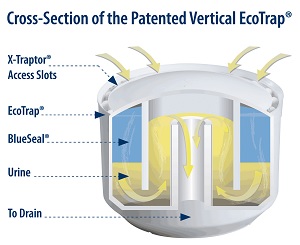 The concept of sustainable development and greener ecology has led to the development of waterless toilets and even reusing the soiled water. Defecating in open and the need of Cesspools was eliminated in 1920s with the advent of the indoor plumbing. This luxury brought the waste treatment plants with it and by 1972 first Clean Water Act was formed. The two main factors relating to water in toilets are use of less water and then re-using the grey water. For using less water the simplest and most prevalent is the twin flush button: giving to amount of water flushed as per the need of the act.
The concept of sustainable development and greener ecology has led to the development of waterless toilets and even reusing the soiled water. Defecating in open and the need of Cesspools was eliminated in 1920s with the advent of the indoor plumbing. This luxury brought the waste treatment plants with it and by 1972 first Clean Water Act was formed. The two main factors relating to water in toilets are use of less water and then re-using the grey water. For using less water the simplest and most prevalent is the twin flush button: giving to amount of water flushed as per the need of the act.
Many an innovative ideas have been developed for reusing the waste water right from separating the water types and using it for irrigation, reusing again for flushing the toilets to charging of aquifers. Many a hotels and motels have connected their urinals to a basic treatment system and the water is flushed directly to their lush green lawns and plantations. This one trend should be taken up by everyone in our country as well. Treating the water for reusing and making the public accept is a tedious and a costly affair but even foreign countries are providing subsidies to encourage the use of treated water. It is high time since measures for the concept of ‘Toilet to Tap’ were adopted in this country. India has still to come a long way to revive and rebuilt its lost glory in terms of waste management and water reuse.
|
|||||||||||||||||||||||
|
Evolution of Bathrooms from the oldest of the times to the present is very interesting. But earlier people were more concerned about the art of cleanliness and had a very elaborative artistic approach towards hygienic aspects. So much that they considered it equivalent to worshipping. They were more sympathetic towards environment and other living organisms and not to forget their concern about older and handicapped people.
In the present trend to excel and deliver the best of the state of the art technology the gist of the concept and the essence of concern towards fellow living beings and Mother Nature should not be forgotten. No doubt breakthroughs have been made in terms of inculcating green technology in terms of tabbing and use of solar energy, hydel power, recycling of refuse water, charging of aquifers, controlling surface run-offs etc. But of late our major concern is about projecting new technologies and design ideas. Rather than concentrating on managing are resources and replenishing are stocks we are still concentrating on the short term goals of efficacy and aesthetics. The need is for firmer and quicker measures at a larger scale. The time is ripe not for small scale experimental development but for lawful implementation in totality. We the developed lots still have to learn a lot by unfurling the pages of the History of Bathrooms and Bathing Rituals.
Some of the sites I referred are as follows:
http://www.pureinsideout.com/hamam-turkish-bath.html
http://www.pureinsideout.com/history-of-the-bath.html
http://en.wikipedia.org/wiki/Roman_Baths_(Bath)
http://en.wikipedia.org/wiki/Thermae
http://en.wikipedia.org/wiki/Bathroom
http://www.World Toilet Day Raises Sanitation Awareness - TIME.mht
29-Dec-2013
More by : Rachna